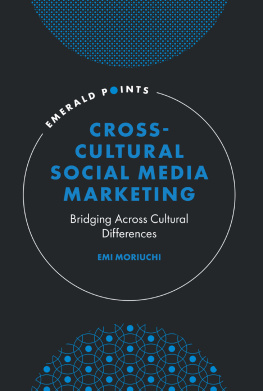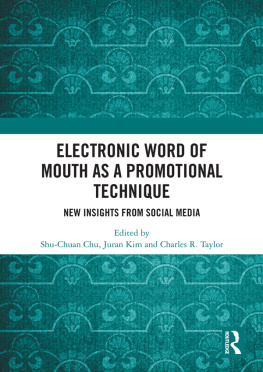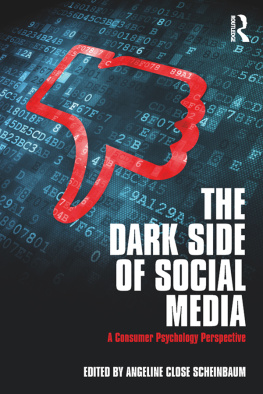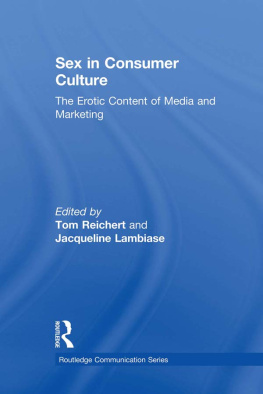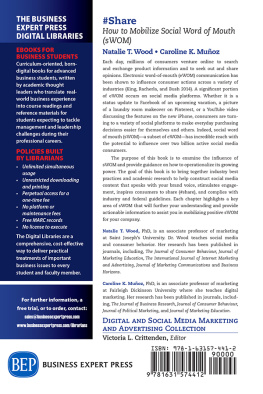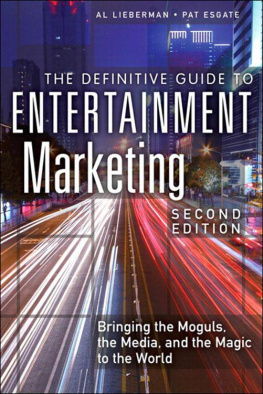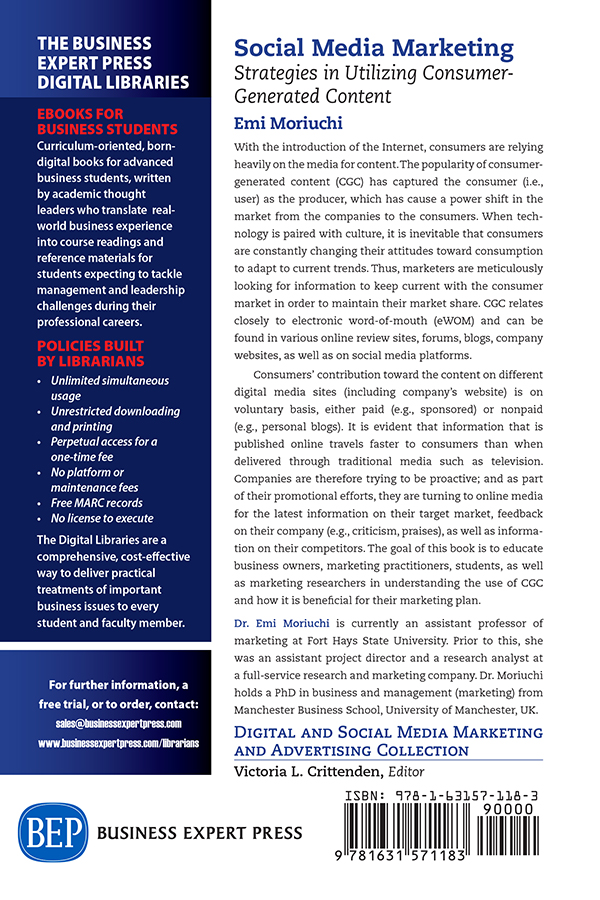
Social Media Marketing
Social Media Marketing
Strategies in Utilizing Consumer-Generated Content
Emi Moriuchi

Social Media Marketing: Strategies in Utilizing Consumer-Generated Content
Copyright Business Expert Press, LLC, 2016.
All rights reserved. No part of this publication may be reproduced, stored in a retrieval system, or transmitted in any form or by any meanselectronic, mechanical, photocopy, recording, or any other except for brief quotations, not to exceed 400 words, without the prior permission of the publisher.
First published in 2016 by
Business Expert Press, LLC
222 East 46th Street, New York, NY 10017
www.businessexpertpress.com
ISBN-13: 978-1-63157-118-3 (paperback)
ISBN-13: 978-1-63157-119-0 (e-book)
Business Expert Press Digital and Social Media Marketing and Advertising Collection
Collection ISSN: 2333-8822 (print)
Collection ISSN: 2333-8830 (electronic)
Cover and interior design by Exeter Premedia Services Private Ltd.,
Chennai, India
First edition: 2016
10 9 8 7 6 5 4 3 2 1
Printed in the United States of America.
Abstract
With the introduction of the Internet, consumers have been relying heavily on the media for content. The popularity of consumer-generated content (CGC) has captured the consumer (i.e., user) as the producer, which has caused a power shift in the market from companies to consumers. When technology is paired with culture, it is inevitable that consumers constantly change their attitudes toward consumption to adapt to current trends. Thus, marketers are meticulously looking for information to stay current with the consumer market in order to maintain their market share. CGC is closely related to electronic word-of-mouth (eWOM) and is found on various online review sites, forums, blogs, company websites, and social media platforms. Consumers contribution toward the content on different digital media sites (including a companys website) is voluntary, either paid (e.g., sponsored) or nonpaid (e.g., personal blogs). It is evident that information that is published online travels faster to consumers than when delivered through traditional media such as television. Thus, companies are trying to be proactive and, as a part of their promotional efforts, are turning to online media for the latest information on their target market, feedback on their company (e.g., criticism, praises), and information on their competitors. However, despite the convenience of knowledge transfer via the Internet, there are still disadvantages of the use of CGC. The goal of this book is to educate business owners, marketing practitioners, students, and marketing researchers about the use of CGC and how it is beneficial for their marketing plan.
Keywords
consumer behavior, consumer decision-making, consumer-generated content, content marketing, cross-national, culture, marketing communication, process, social media, storytelling
Contents
Is our life getting more convenient and more complex at the same time? Research shows that with social media taking the consumer market by storm, companies no longer have the option to stay out of the virtual community. As the power shifts from companies to consumer, companies are scrambling to find means and ways to retain as well as capture new customers. How else should companies know what consumers want? The answer is to listen.
Consumer-generated content (CGC) largely occurs on new media and this new media is a paradigm shift in social media marketing. Although the Internet allows direct communication between consumers and consumers or businesses and consumers (or both), the amount of exposure (e.g., online ads) is not necessarily voluntary for consumers. With the birth of social media, consumers are now in control of what they want to see and what they want to use as valuable information in their decision-making process (e.g., purchase intentions).
The purpose of this book is to organize and clarify key information about CGC. This information is intended to benefit small business owners, marketing practitioners, students, and marketing researchers in understanding the use of CGC as part of a marketing plan.
We begin the book by defining the term CGC. CGC is often linked to electronic word-of-mouth (eWOM) as well as to social media. We next discuss the role of consumers as CGC contributors and the changing landscape of marketing communications.
We also review the different forms of CGC (e.g., reviews, blogs, and collaborative content), in addition to looking at why CGC is so popular in the consumer market; specifically, we examine the core characteristics of CGC. The consumers motivation to contribute to CGC is also an important element of this book. Since CGC is deemed to be more credible than company-published content, we want to understand how and why companies can motivate their target consumers to contribute to CGC.
In order to look at CGC from a global perspective, three countries were selected, on the basis of their cultural orientations and acceptance toward social media: the United States of America, Japan, and Singapore. The United States, known to be the first mover in major social media, is generally populated with individualistic consumers, whereas Japanese consumers are commonly categorized as collectivistic. Singaporean consumers are often considered bicultural. They may be of Asian descent but their cultural orientation is fairly westernized. The book focuses on how these different types of consumers adapt toward social media and their willingness to engage in CGC.
With the large amounts of information posted online, how do we know which information to trust? This book will focus on trust on CGC. In addition, we adopt a case to exemplify consumers opinion about using certain platforms. Research demonstrates that CGC has a great impact on the consumer market. Companies are thus faced with both opportunities and challenges when dealing with CGCs either on their corporate website or on a social media site.
Last but not the least, we present an overview of the future of CGC, the positive and negatives of CGC as well as opportunities for marketers. This book should benefit and share useful information to a broad audience, including marketing practitioners, students, and professors teaching marketing. This book is also a concise read for business managers interested in promoting their business using CGC (maybe even a norm now) with new social media tools.
I would like to thank the publisher, Business Expert Press, for giving me this opportunity to express my interest in this book. I would also like to extend my gratitude toward my editor, Dr. Vicky L. Crittenden, for giving me constructive feedback for continuous improvements.
Last but not the least, I would like to thank my family members. Thanks to my brother for the Singapore piece in this book. Mom and Dad, thank you for being so understanding. Thank you Tse, for your continuous support, and Kyler for letting mommy write.
With the introduction of the Internet, individuals have become increasingly dependent on their mobile devices as these devices give them access to the digital world in seconds. Regardless of whether consumers are trying to obtain, accept, or deliver information, or simply just searching for it, they are relying on the digital environment as their source for information.


